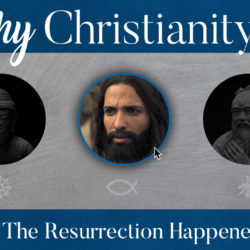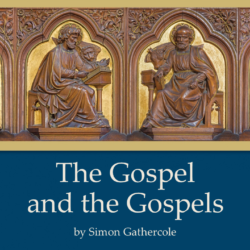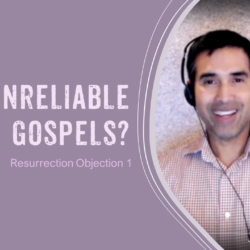Apologetics 7: Evidence for the Resurrection
During this lecture, I played a video of William Lane Craig making a case for the historicity of Jesus’ resurrection from the dead. What’s so brilliant about Craig’s approach is that he doesn’t assume the bible is true to make his case. He treats the Gospels and Paul’s letters as normal historical sources and uses the standard historiography of skeptics and atheists to establish this ancient miracle. He employs the minimal facts strategy, arguing that (1) the honorable burial, (2) the empty tomb, (3) the appearances, and (4) the resurrection belief are agreed to by critical scholars. Thus, the hypothesis, “God raised Jesus of Nazareth from the dead,” is the best historical explanation of facts.
If you would like to take this class for credit, please contact the Atlanta Bible College so you can register and do the necessary work for a grade.
Notes:
Four Historical Facts Agreed upon by Most Historical Jesus Scholars
1. Honorable Burial: Jesus was buried by Joseph Arimethea in a known grave
- attested by very old tradition in 1 Cor 15
- uses technical rabbinic terminology for tradition
- formulaic
- Paul received this within 5 years of his crucifixion
- burial story is part of an old source used by Mark when he wrote
- most of Mark is like pearls on a string, but once we get to the passion narrative it is smooth and chronological….which suggests that the passion narrative was from an actual written source
- gospels don’t diverge until after the burial account
- as a member of the Sanhedrin, Joseph of Arimathea is unlikely to be a Christian invention
- strong resentment toward Jewish leadership responsible for the execution of Jesus so it is highly improbable that Christians would invent that a member of the very court that condemned Christ would be the one to give him an honorable burial
- no competing burial story exists
- no controversy over the issue
- if it were false, we should expect to find some historical trace of what really happened
2. Empty Tomb: On Sunday after the crucifixion women found the empty tomb
- empty tomb is in pre-Markan passion source
- Mark’s source did not end with burial but with empty tomb
- old tradition in 1 Cor 15 implies an empty tomb
- “that he was buried and that he was raised” clearly implies an empty grave was left behind
- apostolic preaching in the book of Acts
- Mark’s story is simple and lacks signs of legendary embellishment
- compare to Gospel of Peter (from 2nd half of 2nd century)…tomb is surrounded by Roman guard and by chief priests, Pharisees, and a huge crowd….suddenly during the night a voice rings out….three gigantic figures come out of the tomb with heads reaching to the sun….the cross comes out of the tomb and speaks
- women’s testimony was less trustworthy than men counts in favor of the women’s role in the discovery of the empty tomb
- Josephus says, “due to the levity and temerity of their sex, women should not be allowed to serve as legal witnesses in a court of law”
- any later legendary account would have made male disciples like Peter and John to be the first to discover the empty tomb
- earliest Jewish allegation that the disciples had stolen Jesus’ body presupposes that the body was in fact missing from the tomb
3. Appearances: on multiple occasions and under a variety of circumstances, individuals and groups of people experienced appearances of Jesus after his death
- list of eyewitnesses quoted by Paul in 1 Cor 15
- Paul actually knew these people
- appearance traditions in the Gospels provides multiple early independent attestation
- Matthew, Mark, Luke, John, Paul
- appearances have earmarks of historicity
- neither James nor his brothers were believers during Jesus’ life time but they became pillars of Christianity (cf. Josephus)
- what would it take to convince you that your brother is the Messiah so that you would be willing to die for this belief?
4. Resurrection Belief: origin of disciples belief in resurrection despite having every reason to the contrary
- their leader was dead
- Jews had no belief in a dying, much less rising, Messiah
- according to a Jewish law, his execution showed him to be a man under God’s curse
- crucifixion proved that Jesus was not on God’s side
- Jewish beliefs about the afterlife precluded anyone’s rising from the dead to immortality prior to the general resurrection at the end of the world
- yet the disciples did believe in his resurrection and went to their deaths for that belief
- some sort of powerful transformative experience was necessary to launch this movement
Six Tests for Best Explanation
- has great explanatory scope
- explains empty tomb, appearances, Christian faith came into being
- has great explanatory power
- plausible
- given the historical context of Jesus’ own unparalleled life and claims resurrection provides vindication
- not ad hoc (contrived)
- requires only one additional hypothesis, i.e. that God exists
- in accord with accepted beliefs
- the belief “God raised Christ from the dead” does not conflict with the belief that “people do not normally rise from the dead”
- outstrips rival hypotheses in meeting criteria 1-5
- other naturalistic hypotheses have been universally disproved by scholars
Possible Explanations
- God raised Jesus from the dead
- Conspiracy hypothesis
- disciples stole the body
- Apparent dead hypothesis
- swoon theory
- Hallucination hypothesis
- Twin hypothesis
Evidence Is So Good that…
- twin hypothesis
- Jewish scholar was convinced that the God of Israel raised Jesus






